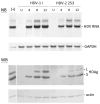Investigating the Genetic Diversity of Hepatitis Delta Virus in Hepatocellular Carcinoma (HCC): Impact on Viral Evolution and Oncogenesis in HCC
- PMID: 38932110
- PMCID: PMC11209585
- DOI: 10.3390/v16060817
Investigating the Genetic Diversity of Hepatitis Delta Virus in Hepatocellular Carcinoma (HCC): Impact on Viral Evolution and Oncogenesis in HCC
Abstract
Hepatitis delta virus (HDV), an RNA virus with two forms of the delta antigen (HDAg), relies on hepatitis B virus (HBV) for envelope proteins essential for hepatocyte entry. Hepatocellular carcinoma (HCC) ranks third in global cancer deaths, yet HDV's involvement remains uncertain. Among 300 HBV-associated HCC serum samples from Taiwan's National Health Research Institutes, 2.7% (8/300) tested anti-HDV positive, with 62.7% (5/8) of these also HDV RNA positive. Genotyping revealed HDV-2 in one sample, HDV-4 in two, and two samples showed mixed HDV-2/HDV-4 infection with RNA recombination. A mixed-genotype infection revealed novel mutations at the polyadenylation signal, coinciding with the ochre termination codon for the L-HDAg. To delve deeper into the possible oncogenic properties of HDV-2, the predominant genotype in Taiwan, which was previously thought to be less associated with severe disease outcomes, an HDV-2 cDNA clone was isolated from HCC for study. It demonstrated a replication level reaching up to 74% of that observed for a widely used HDV-1 strain in transfected cultured cells. Surprisingly, both forms of HDV-2 HDAg promoted cell migration and invasion, affecting the rearrangement of actin cytoskeleton and the expression of epithelial-mesenchymal transition markers. In summary, this study underscores the prevalence of HDV-2, HDV-4, and their mixed infections in HCC, highlighting the genetic diversity in HCC as well as the potential role of both forms of the HDAg in HCC oncogenesis.
Keywords: RNA recombination; cell migration and invasion; delta antigen; hepatitis delta virus; hepatocellular carcinoma.
Conflict of interest statement
The authors declare no conflicts of interest.
Figures






Similar articles
-
Analysis of Replication, Cell Division-Mediated Spread, and HBV Envelope Protein-Dependent Pseudotyping of Three Mammalian Delta-like Agents.Viruses. 2024 May 28;16(6):859. doi: 10.3390/v16060859. Viruses. 2024. PMID: 38932152 Free PMC article.
-
Hepatitis D Virus and Hepatocellular Carcinoma.Viruses. 2021 May 4;13(5):830. doi: 10.3390/v13050830. Viruses. 2021. PMID: 34064419 Free PMC article. Review.
-
Casein kinase II and protein kinase C modulate hepatitis delta virus RNA replication but not empty viral particle assembly.J Virol. 1996 Sep;70(9):6190-8. doi: 10.1128/JVI.70.9.6190-6198.1996. J Virol. 1996. PMID: 8709245 Free PMC article.
-
Hepatitis Delta Virus Alters the Autophagy Process To Promote Its Genome Replication.J Virol. 2020 Jan 31;94(4):e01936-19. doi: 10.1128/JVI.01936-19. Print 2020 Jan 31. J Virol. 2020. PMID: 31748400 Free PMC article.
-
Functional and clinical significance of hepatitis D virus genotype II infection.Curr Top Microbiol Immunol. 2006;307:173-86. doi: 10.1007/3-540-29802-9_9. Curr Top Microbiol Immunol. 2006. PMID: 16903226 Review.
Cited by
-
vHDvDB 2.0: Database and Group Comparison Server for Hepatitis Delta Virus.Viruses. 2024 Aug 5;16(8):1254. doi: 10.3390/v16081254. Viruses. 2024. PMID: 39205227 Free PMC article.
References
Publication types
MeSH terms
Substances
Associated data
- Actions
Grants and funding
LinkOut - more resources
Full Text Sources
Medical

